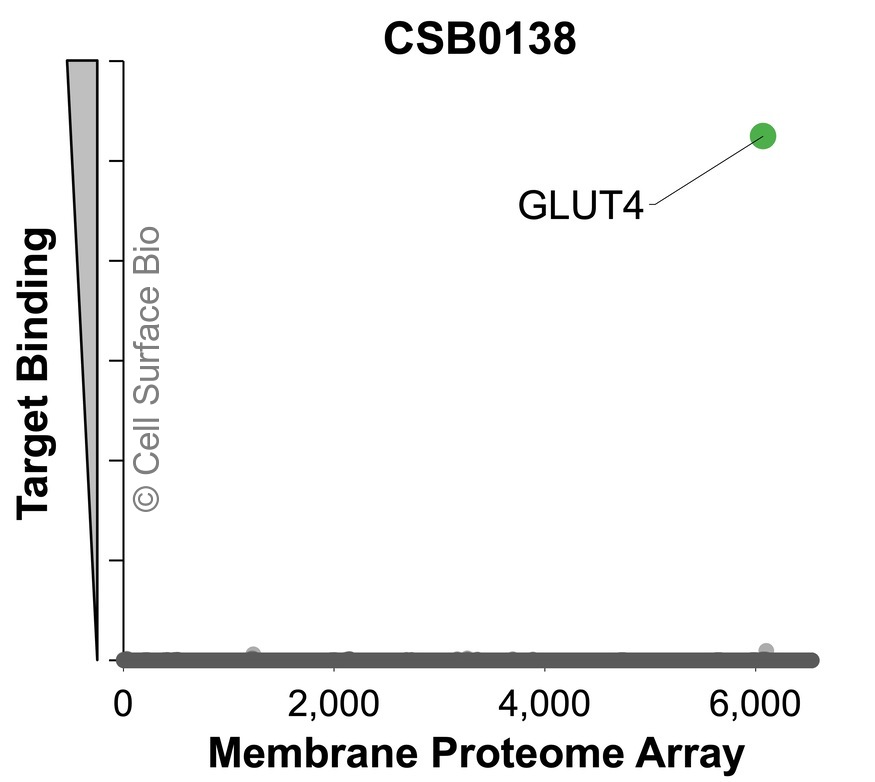Specificity of Monoclonal Antibodies
At CSB, we understand that you are relying on the monoclonal antibodies (MAbs) you use to be specific to their target. You are committing your experimental data – and your time in the lab gathering that data – to that MAb. That’s why we test every monoclonal antibody for specificity against the entire human membrane proteome. No other antibody company in the world guarantees that level of specificity. If you trust your antibodies, you can trust your data.
Approximately 25% of all monoclonal antibodies demonstrate polyspecificity and bind to unintended targets 1. Most often, these off-targets are not related family members (which are usually tested during discovery) but completely unrelated proteins that would be impossible to predict 2-3. Lack of antibody specificity has led to false conclusions in the scientific community and has even caused severe adverse events including patient deaths and drug withdrawals from the market 4-8.
Comprehensive Specificity Testing of CSB’s VeRSaMAbs
At CSB, we raise the bar and overcome the pitfalls of polyspecificity by testing every CSB VeRSaMAb on the Membrane Proteome Array (MPA) of 6,000 human membrane proteins. The MPA is the leading solution for antibody specificity profiling and contains the largest set of human membrane proteins available on the market. The MPA has been validated by hundreds of customers through biopharma and is routinely used in IND-applications to demonstrate specificity to the FDA. CSB brings that same level of specificity required by the FDA to your reagent.
Key features of the MPA:
- Antibody screening against 6,000 native human membrane proteins expressed in live cells, representing 94% of the membrane proteome
- Leading solution for antibody specificity profiling, consisting of the largest collection of human membrane proteins (including heterocomplexes) available on the market
- Binding measured via high sensitivity flow cytometry in unfixed cells, ensuring native protein conformation and preventing false positives and false negatives

Figure 1. CSB0138, pictured above, screened on the MPA at 1μg/mL shows specificity to target (GLUT4)9 with no off targets.
Antibody specificity screening using the Membrane Proteome Array defines specificity far beyond traditional monoclonal antibody testing. Each CSB MAb is tested against individual cell lines overexpressing each of the 6,000 membrane proteins. By using an over-expression system where every protein is tagged to ensure expression, we avoid any false negatives due to poor expression. No other antibody company in the world carries out the extensive specificity profiling that we do. At CSB, we understand that the quality of your data depends on the quality of your antibody.
References
(1) J.A. Cavagnaro; M.E. Cosenza. Translational Medicine: Optimizing Preclinical Safety Evaluation of Biopharmaceuticals; 2021; Vol. Chapter 11.
(2) Screnci B, Stafford LJ, Barnes T, Shema K, Gilman S, Wright R, Al Absi S, Phillips T, Azuelos C, Slovik K, Murphy P, Harmon DB, Charpentier T, Doranz BJ, Rucker JB, Chambers R. Antibody specificity against highly conserved membrane protein Claudin 6 driven by single atomic contact point. iScience. 2022 Nov 24;25(12):105665. https://doi.org/10.1016/j.isci.2022.105665.
(3) Tucker GC, Aoyama H, Lipinski M, Tursz T, Thiery JP. Identical reactivity of monoclonal antibodies HNK-1 and NC-1: conservation in vertebrates on cells derived from the neural primordium and on some leukocytes. Cell Differ. 1984 Aug;14(3):223-30. https://doi.org/10.1016/0045-6039(84)90049-6.
(4) Hamdani, N.; van der Velden, J. Lack of Specificity of Antibodies Directed against Human Beta-Adrenergic Receptors. Naunyn-Schmiedeberg’s Archives of Pharmacology 2009, 379 (4), 403–407. https://doi.org/10.1007/s00210-009-0392-1.
(5) Herrera, M.; Sparks, M. A.; Alfonso-Pecchio, A. R.; Harrison-Bernard, L. M.; Coffman, T. M. Lack of Specificity of Commercial Antibodies Leads to Misidentification of Angiotensin Type 1 Receptor Protein. Hypertension 2013, 61 (1), 253–258. https://doi.org/10.1161/HYPERTENSIONAHA.112.203679.
(6) Pradidarcheep, W.; Stallen, J.; Labruyère, W. T.; Dabhoiwala, N. F.; Michel, M. C.; Lamers, W. H. Lack of Specificity of Commercially Available Antisera against Muscarinergic and Adrenergic Receptors. Naunyn-Schmiedeberg’s Archives of Pharmacology 2009, 379 (4), 397–402. https://doi.org/10.1007/s00210-009-0393-0.
(7) Jensen, B. C.; Swigart, P. M.; Simpson, P. C. Ten Commercial Antibodies for Alpha-1-Adrenergic Receptor Subtypes Are Nonspecific. Naunyn-Schmiedeberg’s Archives of Pharmacology 2009, 379 (4), 409–412. https://doi.org/10.1007/s00210-008-0368-6.
(8) Rhodes, K. J.; Trimmer, J. S. Antibodies as Valuable Neuroscience Research Tools versus Reagents of Mass Distraction. J. Neurosci. 2006, 26 (31), 8017. https://doi.org/10.1523/JNEUROSCI.2728-06.2006.
(9) Diaz-Vegas A, Norris DM, Jall-Rogg S, Cooke KC, Conway OJ, Shun-Shion AS, Duan X, Potter M, van Gerwen J, Baird HJ, Humphrey SJ, James DE, Fazakerley DJ, Burchfield JG. A high-content endogenous GLUT4 trafficking assay reveals new aspects of adipocyte biology. Life Sci Alliance. 2022 Oct 25;6(1):e202201585. https://doi.org/10.26508/lsa.202201585
